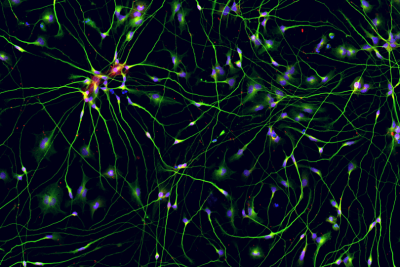Quick-Neuron™ Cholinergic - Human iPSC-derived Neurons (Healthy Control - standard)
| Short Description | Cryopreserved human iPSC-derived cholinergic neurons from Healthy Control patient |
|---|---|
| Product Components | Cryopreserved cells, Component N1, Component A, and Component P |
| Starting Material | iPSCs derived from peripheral blood mononuclear cells (CIRM line CW50065) |
| Product Use | This product is for research use only. It is not approved for use in humans or for therapeutic or diagnostic use. |
| Storage Conditions | Frozen cells should be stored in liquid (vapor phase). The rest of the components should be stored at -20°C. |
| Cell Type | Cholinergic Neurons |
| Culture Type | Feeder Cell-Free |
| Disease | Healthy Control |
| Donor Sex | Female |
| Donor Race Ethnicity | Caucasian, not Latino |
| Patient History | See Resources section for more information. |
| Reprogramming Method | Episomal vector |
| Induction Method | Transcription factors delivered by Sendai virus |
| Growth Properties | Adherent |
| Shipping Conditions | Dry ice (domestic) or liquid nitrogen (international) |
| Shelf Life | 1 year |
| Donor Age At Sampling | 74 |
What kind of transcription factors are used for differentiation induction?
It is a proprietary formulated RNA and cannot be disclosed.
Why does a reagent in my differentiation kit have less than the required volume?
For reagents supplied in small volumes, be sure to briefly centrifuge before use. If pipettors have been calibrated recently and the volume is less than it is supposed to be even after the tube is spun down, please contact us at [email protected].
Do I need a license agreement for any of Elixirgen Scientific’s products?
No. You don't need any licence or material transfer agreement (MTA) to use our differentiation kits or iPSC-derived cells. However, please be advised that these products are for research use only.
Is Sendai virus (SeV) dangerous?
SeV is not pathogenic to humans (i.e., humans are not the natural host of the virus) and the infection does not persist in immunocompetent animals. Furthermore, SeV used in our kits does not produce infectious viral particles upon transduction to host hPSCs and is a temperature-sensitive mutant, such that it is active at 33℃ but becomes inactive at 37℃. However, because SeV can be transmitted by aerosol and contact with respiratory secretions and is highly contagious, appropriate care must be taken to prevent potential mucosal exposure to the virus. Our SeV-based kits must be used under Biosafety Level 2 (BL-2) containment with a biological safety cabinet or a laminar flow hood and with appropriate personal protective equipment. In the event that the virus comes into contact with skin or eyes, decontaminate the affected area by flushing with plenty of water and follow the safety manual prepared by your laboratory and approved by your Institutional Biosafety Committee.
Will SeV remain active after differentiation?
No. The SeV used in our kits is a temperature-sensitive mutant that is active at 33℃ but becomes inactive at 37℃, which is the temperature instructed in the user guides post-differentiation.
Does Quick-Tissue™ technology leave a genetic footprint?
Sendai virus (SeV) is an RNA virus, so it does not integrate into the genomic DNA. In principle, a foreign gene introduced intracellularly in the form of RNA is quickly translated and expressed because, unlike DNA, RNA does not need to enter the nucleus for forced expression, thereby providing no chance of mutagenesis. This is discussed in the following review paper: Yamamoto, et al., (2009) "Current prospects for mRNA gene delivery." Eur. J. Pharm Biopharm 71, 484-489.
What kind of RNA is used for differentiation induction?
It is a proprietary formulated RNA and cannot be disclosed.



